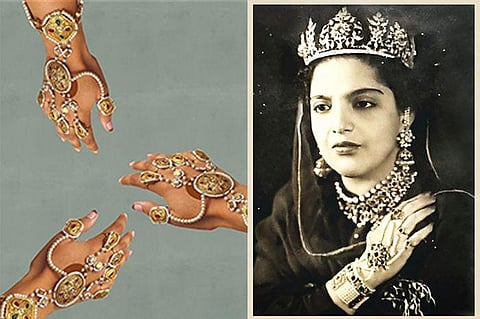
- HOMEGROWN WORLD
- #HGCREATORS
- #HGEXPLORE
- #HGVOICES
- #HGSHOP
- CAREERS
- ABOUT US
- CONTACT US

Jewellery is a significant part of daily wear in the subcontinent. Although it can be used to denote wealth, status or class, it is also used to represent one’s inner self. Far more than a means of adornment, it is a proud embrace of our roots. A testament to unparalleled artistry, Indian jewellery is an amalgamation of the different cultural influences that have shaped the country over the years.
An ornament with a rich history related to many cultures around the globe, Haath Phool (hand flower), also known as Haath Kamal (lotus flower), typically consists of a wrist bracelet which is attached to a circular ornament or medallion resting on the back of the palm with the help of beaded strands. This is then connected to the five fingers where an Arsi (mirror ring) might be attached. An arsi ring was traditionally worn on the thumb; it started as a tradition of women wearing them in the Mughal court in order to check their reflections.
The haath phool was introduced to the country by way of Persia during the Mughal reign and was prominent in Caucasia, Russia, Arab countries, and even in China. Mughal queens were the first to adopt the Haath Phool but their popularity is attributed to courtesans who furthered the usage of the ornament in Rajput and Nawab kingdoms. Within gypsies and nomads, the design underwent a drastic change, with cheaper materials of metal and alloy replacing the precious stones. Worn by Muslim, Hindu and Sikh women alike, each community crafted their own versions, interpreting it in a unique way.
Today the Hindu bride incorporates this piece of jewellery in her sixteen bridal ornaments, also known as Solah Shringar (related to the sixteen phases of the moon, according to Hindu mythology). This historic practice of decorating one’s hands dates back to the Vedic period and showcases the beauty of Indian aesthetics, which has at times borrowed artistic innovations from different cultures.
The haath phool has such prominence due to its relevance with the decorative symbolism of Indian culture and the part women played in it. The hands are considered vital for performing prayers or rituals and were usually covered with traditional designs representing the sun (considered auspicious) on the palm. Wearing jewels such as the haath phool is an extension of these concepts.
Modern-day iterations of the haath phool play with material and design, moulding the traditional piece into unique versions, created with present-day sensibilities in mind. The Persian ornament enjoys a contemporary makeover and further adds to the cultural relevance of an ever-evolving piece of jewellery that was once unknown in the Indian subcontinent.
If you enjoyed reading this, we also suggest:
